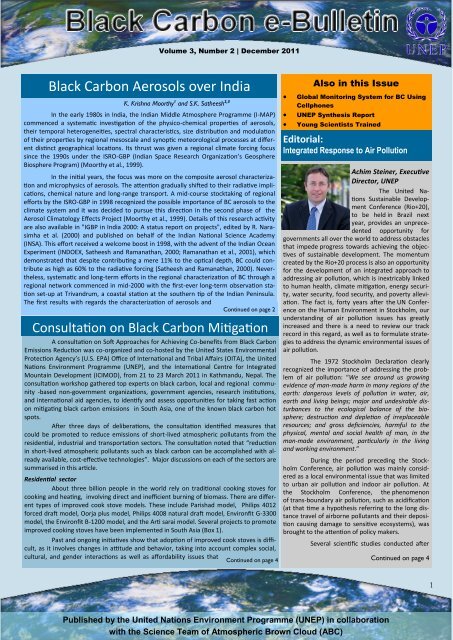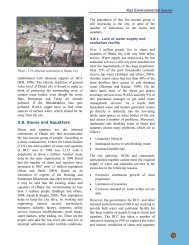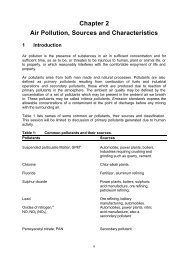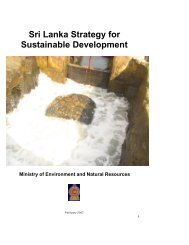Black Carbon e-Bulletin, Volume 3, Issue 2 - Regional Resource ...
Black Carbon e-Bulletin, Volume 3, Issue 2 - Regional Resource ...
Black Carbon e-Bulletin, Volume 3, Issue 2 - Regional Resource ...
You also want an ePaper? Increase the reach of your titles
YUMPU automatically turns print PDFs into web optimized ePapers that Google loves.
<strong>Volume</strong> 3, Number 2 | December 2011<br />
<strong>Black</strong> <strong>Carbon</strong> Aerosols over India<br />
K. Krishna Moorthy 1 and S.K. Satheesh 2,3<br />
In the early 1980s in India, the Indian Middle Atmosphere Programme (I-MAP)<br />
commenced a systematic investigation of the physico-chemical properties of aerosols,<br />
their temporal heterogeneities, spectral characteristics, size distribution and modulation<br />
of their properties by regional mesoscale and synoptic meteorological processes at different<br />
distinct geographical locations. Its thrust was given a regional climate forcing focus<br />
since the 1990s under the ISRO-GBP (Indian Space Research Organization’s Geosphere<br />
Biosphere Program) (Moorthy et al., 1999).<br />
In the initial years, the focus was more on the composite aerosol characterization<br />
and microphysics of aerosols. The attention gradually shifted to their radiative implications,<br />
chemical nature and long-range transport. A mid-course stocktaking of regional<br />
efforts by the ISRO-GBP in 1998 recognized the possible importance of BC aerosols to the<br />
climate system and it was decided to pursue this direction in the second phase of the<br />
Aerosol Climatology Effects Project (Moorthy et al., 1999). Details of this research activity<br />
are also available in "IGBP in India 2000: A status report on projects", edited by R. Narasimha<br />
et al. (2000) and published on behalf of the Indian National Science Academy<br />
(INSA). This effort received a welcome boost in 1998, with the advent of the Indian Ocean<br />
Experiment (INDOEX, Satheesh and Ramanathan, 2000; Ramanathan et al., 2001), which<br />
demonstrated that despite contributing a mere 11% to the optical depth, BC could contribute<br />
as high as 60% to the radiative forcing (Satheesh and Ramanathan, 2000). Nevertheless,<br />
systematic and long-term efforts in the regional characterization of BC through a<br />
regional network commenced in mid-2000 with the first-ever long-term observation station<br />
set-up at Trivandrum, a coastal station at the southern tip of the Indian Peninsula.<br />
The first results with regards the characterization of aerosols and<br />
Continued on page 2<br />
Consultation on <strong>Black</strong> <strong>Carbon</strong> Mitigation<br />
A consultation on Soft Approaches for Achieving Co-benefits from <strong>Black</strong> <strong>Carbon</strong><br />
Emissions Reduction was co-organized and co-hosted by the United States Environmental<br />
Protection Agency’s (U.S. EPA) Office of International and Tribal Affairs (OITA), the United<br />
Nations Environment Programme (UNEP), and the International Centre for Integrated<br />
Mountain Development (ICIMOD), from 21 to 23 March 2011 in Kathmandu, Nepal. The<br />
consultation workshop gathered top experts on black carbon, local and regional community<br />
-based non-government organizations, government agencies, research institutions,<br />
and international aid agencies, to identify and assess opportunities for taking fast action<br />
on mitigating black carbon emissions in South Asia, one of the known black carbon hot<br />
spots.<br />
After three days of deliberations, the consultation identified measures that<br />
could be promoted to reduce emissions of short-lived atmospheric pollutants from the<br />
residential, industrial and transportation sectors. The consultation noted that “reduction<br />
in short-lived atmospheric pollutants such as black carbon can be accomplished with already<br />
available, cost-effective technologies”. Major discussions on each of the sectors are<br />
summarised in this article.<br />
Residential sector<br />
About three billion people in the world rely on traditional cooking stoves for<br />
cooking and heating, involving direct and inefficient burning of biomass. There are different<br />
types of improved cook stove models. These include Parishad model, Philips 4012<br />
forced draft model, Oorja plus model, Philips 4008 natural draft model, Environfit G-3300<br />
model, the Environfit B-1200 model, and the Arti sarai model. Several projects to promote<br />
improved cooking stoves have been implemented in South Asia (Box 1).<br />
Past and ongoing initiatives show that adoption of improved cook stoves is difficult,<br />
as it involves changes in attitude and behavior, taking into account complex social,<br />
cultural, and gender interactions as well as affordability issues that<br />
Continued on page 4<br />
Also in this <strong>Issue</strong><br />
Global Monitoring System for BC Using<br />
Cellphones<br />
UNEP Synthesis Report<br />
Young Scientists Trained<br />
Editorial:<br />
Integrated Response to Air Pollution<br />
Achim Steiner, Executive<br />
Director, UNEP<br />
The United Nations<br />
Sustainable Development<br />
Conference (Rio+20),<br />
to be held in Brazil next<br />
year, provides an unprecedented<br />
opportunity for<br />
governments all over the world to address obstacles<br />
that impede progress towards achieving the objectives<br />
of sustainable development. The momentum<br />
created by the Rio+20 process is also an opportunity<br />
for the development of an integrated approach to<br />
addressing air pollution, which is inextricably linked<br />
to human health, climate mitigation, energy security,<br />
water security, food security, and poverty alleviation.<br />
The fact is, forty years after the UN Conference<br />
on the Human Environment in Stockholm, our<br />
understanding of air pollution issues has greatly<br />
increased and there is a need to review our track<br />
record in this regard, as well as to formulate strategies<br />
to address the dynamic environmental issues of<br />
air pollution.<br />
The 1972 Stockholm Declaration clearly<br />
recognized the importance of addressing the problem<br />
of air pollution: “We see around us growing<br />
evidence of man-made harm in many regions of the<br />
earth: dangerous levels of pollution in water, air,<br />
earth and living beings; major and undesirable disturbances<br />
to the ecological balance of the biosphere;<br />
destruction and depletion of irreplaceable<br />
resources; and gross deficiencies, harmful to the<br />
physical, mental and social health of man, in the<br />
man-made environment, particularly in the living<br />
and working environment.”<br />
During the period preceding the Stockholm<br />
Conference, air pollution was mainly considered<br />
as a local environmental issue that was limited<br />
to urban air pollution and indoor air pollution. At<br />
the Stockholm Conference, the phenomenon<br />
of trans-boundary air pollution, such as acidification<br />
(at that time a hypothesis referring to the long distance<br />
travel of airborne pollutants and their deposition<br />
causing damage to sensitive ecosystems), was<br />
brought to the attention of policy makers.<br />
Several scientific studies conducted after<br />
Published by the United Nations Environment Programme (UNEP) in collaboration<br />
with the Science Team of Atmospheric Brown Cloud (ABC)<br />
Continued on page 4<br />
1
the impact of anthropogenic activities in modulating their concentrations<br />
were brought out by Babu and Moorthy (2001, 2002). Through a<br />
focused field experiment, Babu et al (2002) brought out for the first<br />
time in India the radiative impact of enhanced BC absorption from an<br />
urban site. Subsequently, there has been gradual and planned proliferation<br />
of this activity in India, which eventually led to the formation of a<br />
national network called the ARFINET (note the circles in Figure 1): ARFI<br />
stands for Aerosol Radiative Forcing over India. This has resulted in a<br />
large number of publications (Babu et al., 2002; Padithurai et al., 2004;<br />
Ganguly et al., 2005; Dumka et al., 2006; Satheesh et al., 2006; Pant et<br />
al., 2006; Moorthy et al., 2004, 2007, 2008; Nair et al., 2007; Niranjan<br />
et al., 2006, 2007; Rengarajan et al., 2007; Satheesh et al., 2008, 2009).<br />
However, most of these publications pertained to BC characteristics<br />
near the surface, or within the planetary boundary layer.<br />
With a view to characterizing spatial heterogeneity in BC distribution,<br />
a road/land campaign (LC-I) was conducted during February<br />
to March 2004, under the ISRO-GBP over Central/Peninsular India. Simultaneous<br />
measurements were made over spatially separated locations,<br />
using identical and inter-compared instruments over the course of a<br />
month from land based mobile laboratories, and generated a wealth of<br />
information on black carbon as well as other aerosol species (Moorthy<br />
et al., 2004, Ganguly et al., 2005). These observations revealed that<br />
coastal areas, in general, have<br />
higher aerosol mass concentrations<br />
(>50 µg/m 3 ) in case of both<br />
the east and west coasts (Moorthy<br />
et al., 2005). By comparison, the<br />
inland regions have lower mass<br />
concentrations (
Reliable and cost-effective systems to measure near-surface<br />
black carbon (BC) concentrations globally are necessary in order to<br />
validate air pollution and climate models and to evaluate the effec-<br />
tiveness of BC mitigation actions.<br />
Towards this goal, the Surya Team led by Nithya Rama-<br />
nathan, developed and validated a new wireless, low-cost, ultra low-<br />
power, BC cellphone-based monitoring system (BC_CBM).<br />
BC_CBM integrates a miniaturized aerosol filter sampler<br />
with a cellphone to carry out filter image collection, transmission and<br />
image analysis in order to determine BC concentrations in near real-<br />
time.<br />
Surya Team Develops a Global Monitoring System for BC Using<br />
Cellphones<br />
The Surya Team, using the BC_CBM system and working on<br />
field data collected from vastly different environments, ranging from<br />
southern California to rural regions in the Indo-Gangetic Plains of<br />
Northern India, was able to determine BC concentrations well within<br />
the experimental error of two independent reference instruments (an<br />
optical method, and a thermal optical method) for both indoor air and<br />
outdoor ambient air.<br />
For additional details contact: Nithya Ramanathan (nithya@cs.ucla.edu).<br />
ley is one of the largest and most rapidly developing regions of India.<br />
The Ganges River, which provides the region with water needed for<br />
sustaining life, is fed primarily by snow and rainfall associated with the<br />
Indian summer monsoon. Impacts of changes in precipitation patterns,<br />
temperature, and flow of snow-fed rivers could be immense. Recent<br />
satellite-based observations have indicated that the upper Ganges Valley<br />
has some of the highest persistently observed high aerosol optical<br />
depth values. Concerted efforts to understand the complex features<br />
over this region have been mooted under RAWEX. These experiments<br />
would address the scenario arising from the mixing of hygroscopic aerosols<br />
containing hydrophilic and hydrophobic BC compounds at various<br />
mixing states.<br />
In summary, last decade (2000-2010) witnessed substantial<br />
progress in understanding the microphysical, chemical and optical<br />
properties of aerosols over the Indian region and their impact on radiation.<br />
Exhaustive aircraft-based measurements of composite aerosols<br />
and aerosol black carbon have improved our knowledge about the vertical<br />
distribution of aerosols. Observations over the Indian land mass<br />
using instrument-fitted vehicles as well as network sites revealed that<br />
BC mass concentration over coastal areas is higher compared to inland<br />
regions. Measurements of BC using high altitude balloons in the upper<br />
troposphere (up to 10 km) enabled an investigation of the impacts of<br />
BC warming at higher levels on the environmental lapse rate. Comprehensive<br />
studies of the morphological features of aerosols using electron<br />
microscope have revealed that natural dust over India region is contaminated<br />
with BC. However, it appears that there is still a great degree<br />
of uncertainty about the radiative effects of black carbon aerosols over<br />
India.<br />
1 Space Physics laboratory, Vikram Sarabhai Space Centre, Thiruvananthapuram, India (Email: krishnamoorthy_k@vssc.gov.in)<br />
2 Centre for Atmospheric and Oceanic Sciences, Indian Institute of Science, Bangalore, India (Email:<br />
satheesh@caos.iisc.ernet.in)<br />
3 Divecha Centre for Climate Change, Institute of Science, Bangalore, India<br />
<strong>Black</strong> <strong>Carbon</strong> Aerosols ...<br />
References<br />
Babu, S., S.K. Satheesh and K. Krishna Moorthy, Enhanced aerosol radiative forcing due to aerosol black<br />
carbon at an urban site in India, Geophys. Res. Lett., 29 (18), 1880, doi:10.1029 /<br />
2002GL015826, 2002.<br />
Babu SS; Moorthy KK, Anthropogenic impact on aerosol black carbon mass concentration at a tropical<br />
coastal station: A case study, CURRENT SCIENCE, 81, 1208-1214, 2001.<br />
Babu SS; Moorthy KK, Aerosol black carbon over a tropical coastal station in India, Geophys. Res. Lett., 29,<br />
Article Number: 2098, DOI: 10.1029/2002GL015662, 2002.<br />
Babu S. S, S. K. Satheesh, K. Krishna Moorthy, C. B. S. Dutt, Vijayakumar S Nair, Denny P Alappattu and P K<br />
Kunhikrishnan, Aircraft Measurements of Aerosol <strong>Black</strong> carbon from a coastal location in the<br />
north-east part of peninsular India during ICARB, J. Earth. Sys. Sci., 117, 263-272, 2008.<br />
Beegum, SN, K Krishna Moorthy, Vijayakumar S Nair et al., Characteristics of Spectral Aerosol Optical Depths<br />
over India during ICARB, J. Earth. Sys. Sci., 117, 303-314, 2008.<br />
Dumka, U.C. et al., Surface changes in solar irradiance due to aerosols over central Himalayas, J. Geophys.<br />
Res., 33 (20): Art. No. L20809, doi:10.1029/2006GL027814, 2006.<br />
Ganguly D., et al., Single scattering albedo of aerosols over the central India: Implications for the regional<br />
aerosol radiative forcing, Geophys. Res. Lett., 32, L18803, 2005.<br />
Moorthy et al., Aerosol Climatology over India. 1 - ISRO GBP MWR network and database, ISRO/GBP, SR-03-<br />
99, 1999.<br />
Moorthy, K.K.,et al., Altitude profiles of aerosol BC, derived from aircraft measurements over an inland<br />
urban location in India, Geophys. Res. Lett., 31, L22103, 2004.<br />
Moorthy, K.K., et al., Wintertime spatial characteristics of boundary layer aerosols over peninsular India,<br />
Journal of Geophysical Research, 110, D08207, 2005.<br />
Moorthy, K.K., et al., Dust absorption over the "Great Indian Desert" inferred using ground-based and<br />
satellite remote sensing, Journal of Geophysical research, 112, D09206, 2007.<br />
Moorthy, K.K., S.K. Satheesh, SS Babu and CBS Dutt, Integrated Campaign for Aerosols, gases and Radiation<br />
Budget (ICARB): An Overview, J. Earth. Sys. Sci., 117, 243-262, 2008.<br />
Nair VS, Moorthy KK, Alappattu DP, et al., Wintertime aerosol characteristics over the Indo-Gangetic Plain<br />
(IGP): Impacts of local boundary layer processes and long-range transport, Journal of Geophysical<br />
Research, 112, D13205, 2007.<br />
Narasimha et al., IGBP in India: A status report on projects, Indian National Science academy (INSA), 2000.<br />
Niranjan, K., et al., Wintertime aerosol characteristics at a north Indian site Kharagpur in the Indo-Gangetic<br />
plains located at the outflow region into Bay of Bengal, Journal of Geophysical Research,<br />
111, D24209, 2006.<br />
Niranjan, K., et al., Aerosol physical properties and Radiative forcing at the outflow region from the Indo-<br />
Gangetic plains during typical clear and hazy periods of wintertime, Geophysical Research<br />
Letters, 34, L19805, 2007.<br />
Pandithurai, G., et al., Aerosol radiative forcing over a tropical urban site in India, Geophysical research<br />
Letters,31,L12107 ,2004.<br />
Pant, P., et al., Study of aerosol black carbon radiative forcing at a high altitude location, J. Geophys. Res.,<br />
111 (D17): Art. No. D17206, doi:10.1029/2005JD006768, 2006.<br />
Ramanathan, V., P. J. Crutzen, J. Lelieveld, et al., 2001, Indian Ocean experiment: An integrated analysis of<br />
the climate forcing and effects of the great Indo-Asian haze, Geophys. Res., 106(D22), 28371-<br />
28398, doi: 10.1029/2001JD900133.<br />
Rengarajan, R., M.M. Sarin, A.K., Sudheer <strong>Carbon</strong>aceous and inorganic species in atmospheric aerosols<br />
during wintertime over urban and high-altitude sites in North India, Journal of Geophysical<br />
Research, 112, D21307, 2007.<br />
Satheesh SK and V. Ramanathan, Large Difference in Tropical Aerosol Forcing at the Top of the Atmosphere<br />
and Earth’s Surface, Nature, 405, 60-63, 2000.<br />
Satheesh, S.K., J. Srinivasan, V. Vinoj and S. Chandra, New Directions: How representative are aerosol<br />
radiative impact assessments?, Atmospheric Environment 40, 3008–3010, 2006.<br />
Satheesh, S. K., K. Krishna Moorthy, S. Suresh Babu, V. Vinoj and C.B.S. Dutt, 2008, Climate implications of<br />
large warming by elevated aerosol over India, 1008, Geophysical Research Letters, Vol. 35, 1-<br />
6.<br />
Satheesh , S.K., K. K. Moorthy, S. S. Babu, V. Vinoj, V. S. Nair, S. N. Beegum, C.B.S. Dutt, D. P. Alappattu, and<br />
P.K. Kunhikrishnan, Vertical structure and horizontal gradients of aerosol extinction coefficients<br />
over coastal India inferred from airborne lidar measurements during the Integrated<br />
Campaign for Aerosol, Gases and Radiation Budget (ICARB) field campaign, J. Geophys. Res.,<br />
doi:10.1029/2008JD011033, 1-12, 2009.<br />
Vinoj, V., S. K. Satheesh and K. Krishnamoorthy, 2008, Aerosol Characteristics at a Remote Island: Minicoy in<br />
Southern Arabian Sea, J. Earth. Sys. Sci., 117, 389-398.<br />
3
are typically associated with alternative technologies. Involving or not<br />
involving users up front in cookstove design and so on was seen to<br />
play a major role in the appeal, adoption and continued use of improved<br />
cook stoves.<br />
To mitigate black carbon emissions in the residential sector,<br />
particularly with regards indoor air pollution, those present felt the<br />
need for technological interventions, coupled with operational behavioral<br />
changes and changes in local customs and attitudes, to bring<br />
about significant reductions in black carbon emissions. It would also<br />
be useful to introduce new technologies that are culturally acceptable,<br />
desirable, and affordable with efficient options that meet emission<br />
standards sought for cook stoves in particular. While there have<br />
been major technological improvements, more needs to be done in<br />
Box 1: Improved cook stoves offer environmental<br />
and health benefits<br />
Traditional stove<br />
no longer in use<br />
Improved stove<br />
Development and testing of locally fabricated cook stoves by Project Surya<br />
shows significant socio-economic and environmental benefits of improved<br />
cook stoves:<br />
Contribution to climatic benefits- Locally fabricated cook stove will reduce<br />
BC emission by 70% to 80% compared with traditional mud-stoves.<br />
Improved health and living conditions for women and children- Improved<br />
stoves resulted in three immediate benefits to families: (1) significantly<br />
improved kitchen air quality, (2) reduced drudgery in collecting<br />
biomass fuel like wood chips as improved stoves require 50% less<br />
biomass fuel compared with traditional stoves, and (3) shorter cooking<br />
time.<br />
Established sustainable and culturally appropriate or sensitive business<br />
model for the new technology by addressing poverty and cultural<br />
issues associated with successful stove adoption. Customization and<br />
local fabrication reduced cost and increased usage of the stoves and<br />
reduced spending for biomass.<br />
Consultation ...<br />
Editorial ...<br />
terms of addressing local customs and norms and developing of protocols,<br />
standards and benchmarks. All these are important from the<br />
climate, health and sociological perspectives. There is also a need to<br />
set up financial mechanisms to support cook stove initiatives.<br />
A UNEP Synthesis Report Published<br />
To be continued<br />
On 25 November, UNEP published<br />
a synthesis report entitled “Nearterm<br />
Climate Protection and Clean Air<br />
Benefits: Actions for Controlling Short-<br />
Lived Climate Forcers”. The Report is directed<br />
primarily at policy makers and other<br />
stakeholders who have an interest in the<br />
topic and can potentially influence policy<br />
decisions concerning air quality and near-<br />
term climate protection. A digital copy of<br />
the report can be downloaded at<br />
www.unep.org/publications/ebooks/SLCF/<br />
Young Scientists Trained on<br />
Short-lived Atmospheric Pollutants<br />
Once every two years, Project ABC organizes an international<br />
training school to enhance the capacity of young researchers<br />
to understand and formulate theoretical concepts concerning atmospheric<br />
science and to monitor ABCs using various state-of-the-art<br />
instruments. The 4 th training school on ABCs was held in March 2011<br />
in Kathmandu and Nagarkot, Nepal. A total of 34 participants (14<br />
female and 20 male) from 24 institutes from seven developing countries<br />
were trained in recent theoretical advances in atmospheric<br />
science. They also participated in hands-on training in atmospheric<br />
monitoring techniques.<br />
the Stockholm Conference confirmed the hypothesis that air pollutants could travel several thousands of kilometres and cause damage to human<br />
health, agriculture and sensitive ecosystems that are far from their source. This demonstrated the need for international cooperation to address<br />
trans-boundary air pollution. In response to this need, governments established intergovernmental networks and agreements at sub-regional<br />
and regional levels to assess trans-boundary air pollution issues.<br />
During the last decade, scientific studies have unveiled many significant impacts of air pollutants on climate change. For example, black<br />
carbon has been estimated to contribute as much as 27 to 55% of the warming effect caused by carbon dioxide, making it the second or third<br />
strongest anthropogenic warming agent overall. In addition, air pollutants such as tropospheric ozone and methane have been found to cause<br />
strong warming effects. Recent scientific studies suggest that air pollutants can reduce water and food security regionally through their interference<br />
with the hydrological cycle and crop growth. Scientists have also unveiled the complex nature of air pollution issues. Some air pollutants<br />
like sulfates and nitrates reflect solar radiation and have a negative forcing (surface cooling effect), while other air pollutants, in particular black<br />
carbon, absorb solar radiation and have a net positive forcing (surface warming).<br />
Clearly, the time to take an integrated approach to different components of air pollutants and related environmental issues has come.<br />
Existing intergovernmental air pollution networks could be empowered to facilitate such an integrated approach in the context of sustainable<br />
development. It is an opportunity to act, which we should seize at Rio+20.<br />
For further information:<br />
United Nations Environment Programme (UNEP) , United Nations Avenue, Gigiri, P O Box 30552, 00100<br />
Nairobi, Kenya; email: BC<strong>Bulletin</strong>@unep.org





